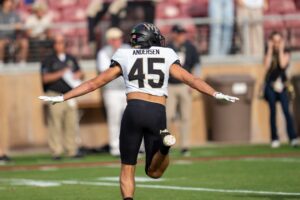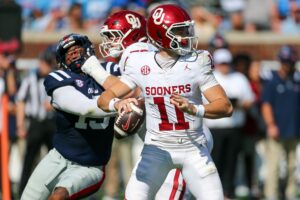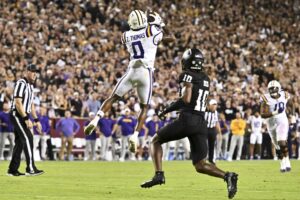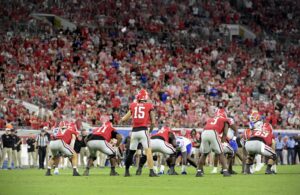What Gives in Morgantown?
In the third quarter of the West Virginia Mountaineers’ failed comeback attempt against Texas Tech, fans unleashed the loudest boos of the Neal Brown era in Morgantown. The Mountaineers were driving the ball efficiently, and Jarret Doege just led the team 71 yards in 6 plays. So what happened? And what gives in Morgantown?
Game Management Problems
The boos came when disorganization on the field forced the head coach to take a timeout early in the half. After setting up a first and goal situation at the four, Brown put Garrett Greene into the game to lead the charge. With the play clock winding down, however, West Virginia looked confused and could not get the ball snapped. Thus, Brown called the timeout.
During Brown’s tenure here, fans have seen this script play out before. For whatever reason, wires cross with alarming frequency. Sitting safely removed from the field of play, we do not know what exactly causes the disconnect. Brown told the media that, in this situation, the right personnel was not on the field. Regardless of the reason, it was deja vu all over again.
Indeed, the team struggled to move the ball in the first half. As a result, there is merit in the thought that we need to get things right in that situation. After all, the Mountaineers consistently struggle to make the most of golden opportunities.
If the team is 3-1 or 4-0 heading into that situation, maybe we do not look as closely at the detail. But the team is 2-2 and just got blanked in the first half by Texas Tech’s second string. And details matter. Brown himself would agree. Details matter. Using a timeout early means one less timeout left late. When you are playing from 17 points down with an offense that had not scored a second-half touchdown against a Power 5 opponent in three games, that matters. When you just lost a critical game that you were never behind in until a last-second field goal sailed through the uprights, that matters.
It’s Not Just Doege’s Fault…
Much of the post-game banter by fans revolves around whether Doege is to blame or not. Look, he played a great second half. 276 of his 318 yards came in the second half. Greene clearly has a very short rope in Brown’s eyes. While a single mistake or two on his account draw Brown’s ire, the head coach vehemently defends Doege.
As fans and media, we do not know exactly why that is. Maybe Greene’s play in practice earns him such a short rope. Maybe the mistakes Greene makes are bigger than we see. And maybe they disrupt the game script in such fundamental ways that it impacts the next dozen plays. We are not afforded that close of a look, and for good reason. The more intimately we understand the flaws and strategies and calls, the more the other teams know. That’s not good.
Doege’s mistakes, however, tend to come at bad times. Yes, he led the charge and tied the game after scoring 17 unanswered points in a single quarter. That is a great quarter of play by any stretch. But let’s also face this fact: it was a bad Texas Tech defense riddled with injury. West Virginia scored 20 points against that defense. Texas just scored 70 the week before. Casey Thompson completed nearly 80% of his passes for 303 yards and five touchdowns. He averaged 13.2 yards per attempt against the Red Raiders. Yes, you read that right: 13.2 yards per attempt.
So, in short, we should be able to move the ball against Texas Tech. That 20 points, by the way, is the least amount given up by the Red Raiders in two seasons outside of the Red Raiders’ 16-13 win over Kansas last year. Teams that have scored more than the Mountaineers include Houston Baptist (31), Houston (21), Stephen F. Austin (22), and Florida International (21). If we are a good team, we should score against Texas Tech, and we should do so at will.
…But He Also Cannot Escape Some Blame
Simply, we remain unimpressed by 20 points in a half against a bad defense decimated by injury. While that is not just Doege’s fault, we certainly had a golden opportunity to take a seven-point lead with four minutes to go. On third and four, however, Doege completely misses a wide-open Winston Wright and then throws at the feet of Leddie Brown, the only receiver who really even got the look.
Perhaps we could forgive that if we did not just see the same thing last week. Driving late against Oklahoma, Doege stares down Bryce Ford-Wheaton who was completely uncovered in the middle of the end zone. The throw must travel 12 yards to a receiver who is literally in a straight line directly in front of Doege. What happened? Doege threw the ball five feet too high, missed the literal blue bullseye in the middle of Ford-Wheaton’s number zero jersey.
That said, we go back to our original point. It is not just Doege’s fault. The remaining offensive woes don’t fall squarely into his lap. Unfortunately for him, his mistakes come into focus much more readily because of the other issues. It is troubling that there is a theme to this year: even our wins leave a sour taste. They almost gave one away late against Virginia Tech, and they couldn’t run the ball at all against LIU. As a result, it always seems as though just a couple of plays lose West Virginia games. We could, after all, point to just two plays as the difference between a 4-1 start and a 2-3 start. Thus, the margin for error with this team remains thin.
What Other Issues?
Coach Brown told us several things over the past three years that start to make sense together. In his first Big 12 Media Days presentation, Brown told fans that he intended to develop a blue-collar ground-and-pound team reminiscent of the Don Nehlen era. In those first few interviews, Brown also pointed to the offensive line as the single-biggest weakness of the team.
Throughout last season, Brown also told us that the team had to find ways to stop beating itself. Basically, he said that the team’s bad performances and mistakes were too bad. They needed to improve the mean. Finally, after the loss in Norman, Brown told fans that West Virginia proved unable to win the track meets with Oklahoma.
Those three comments leave a lot to unpack. Put most simply, there is nothing there Brown said that is untrue, especially in isolation. Yes, the very best plan to beat Oklahoma was to keep the game low-scoring and make it a defensive battle. Overall, being able to control the line of scrimmage and play blue-collar football on demand should be the goal of all teams. And, indeed, limiting the negative impact of your worst plays remains a must in a game of inches.
That said, while we should not try to play Oklahoma or Texas to 100-point shootouts, we should very much expect to be able to drop 30 on Texas Tech.
The Problem With Small Ball
So what gives in Morgantown? Well, this is the problem with the small ball. While playing low-scoring defensive battles minimizes the ability of the opponent to control your fate, that gameplan very much maximizes the impact of your worst when you are controlling the ball.
As a result, when Doege throws an interception, or an All-Freshman center misfires a snap, or an All-Conference guard gives up a few false starts, then you start to find individual players and a very small handful of isolated plays as the differences between wins and losses. That puts added pressure on the team as a whole. The question, though, remains: how do you fix it?
That is certainly a question that Coach Brown will undoubtedly grapple with over the coming weeks. We do not agree with some of our colleagues that Brown’s seat should range from very harmful to blazing hot. If the difference is one more year of experience on the offensive line and a quarterback, well, Brown has all those pieces in play next season. That said, we are starting to actively question: how many more years should we be saying “just wait until next year” before the results speak for themselves.






